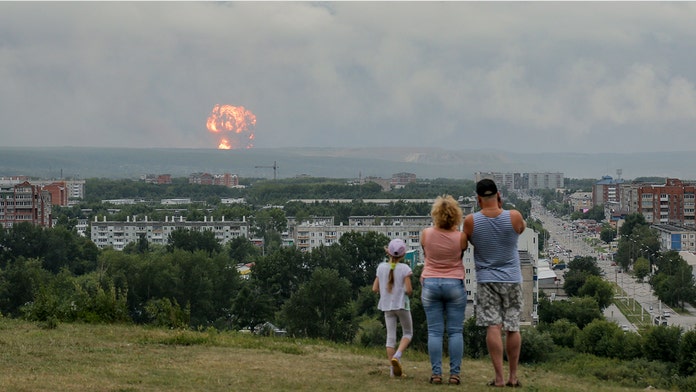- Joined
- Apr 18, 2013
- Messages
- 106,422
- Reaction score
- 96,748
- Location
- Barsoom
- Gender
- Male
- Political Leaning
- Independent
Russia Says Small Nuclear Reactor Blew Up in Deadly Accident
Five Rosatom workers who died were ‘elite nuclear scientists’

Massive explosions at a Russian military depot last week in Siberia.
This accident, which occurred at a Russian Navy proving ground on the northern White Sea, was almost certainly another failed test (#6) of the Burevestnik (SSC-X-9 Skyfall). The Burevestnik is a two-stage cruise missile which utilizes a solid propellant fuel at launch and to attain speed, and then a small nuclear reactor takes over which utilizes the decay of nuclear isotopes to fuel the turbojet engine. Theoretically, such a cruise missile could stay in flight for months. Even 35 years after the Chornobyl catastrophe the Russians are purposefully slow to alert the world to its nuclear accidents. The Kremlin is also developing a nuclear-powered torpedo (Poseidon/Status-6) which will utilize a gas-cooled nuclear reactor for power generation. With theoretically unlimited range, the Russians plan to fit the torpedo with a toxic Cobalt-60 warhead. This very large warhead can be detonated at standoff range but still possess the radioactive coverage (1700x300 kilometers) to contaminate an entire Navy carrier battle group at sea.
Last week a Russian arms depot near the city of Achinsk in eastern Siberia's Krasnoyarsk region was struck by lightening causing fires and cooking off explosives which resulted in massive explosions. This resulted in five dead, 1 injured, 1 missing, and 60,500 people evacuated. In the autumn of 2017 there was a nuclear accident at the Mayak plant located in the southern Urals. This plant supposedly reprocesses nuclear fuel. Aerosols containing ruthenium-106 were detected in countries as far apart as Greece and Norway at the end of September and beginning of October 2017. Moscow denied that Mayak was the source, but scientists in Europe that collected radioactive air samples and ran computerized meteorological weather data in reverse said the Mayak plant is the only location this accident could have occurred at.
Related: Experts point to Russia as source of radioactive ruthenium leak
Five Rosatom workers who died were ‘elite nuclear scientists’

Massive explosions at a Russian military depot last week in Siberia.
8/12/19
The failed missile test that ended in an explosion killing five scientists last week on Russia’s White Sea involved a small nuclear reactor, according to a top official at the institute where they worked. The institute is working on small-scale power sources that use “radioactive materials, including fissile and radioisotope materials” for the Defense Ministry and civilian uses, Vyacheslav Soloviev, scientific director of the institute, said in a video shown by local TV. The men, who will be buried Monday, were national heroes and the “elite of the Russian Federal Nuclear Center,” institute Director Valentin Kostyukov said in the video, which was also posted on an official website in Sarov, a high-security city devoted to nuclear research less than 400 kilometers (250 miles) east of Moscow. The blast occurred Aug. 8 during a test of a missile that used “isotope power sources” on an offshore platform in the Arkhangelsk region, close to the Arctic Circle, Russia’s state nuclear company Rosatom said over the weekend. The Defense Ministry initially reported two were killed in the accident, which it said involved testing of a liquid-fueled missile engine. The ministry didn’t mention the nuclear element. Rosatom declined to comment on the incident Monday and a spokeswoman for the Sarov institute couldn’t immediately be reached.
This accident, which occurred at a Russian Navy proving ground on the northern White Sea, was almost certainly another failed test (#6) of the Burevestnik (SSC-X-9 Skyfall). The Burevestnik is a two-stage cruise missile which utilizes a solid propellant fuel at launch and to attain speed, and then a small nuclear reactor takes over which utilizes the decay of nuclear isotopes to fuel the turbojet engine. Theoretically, such a cruise missile could stay in flight for months. Even 35 years after the Chornobyl catastrophe the Russians are purposefully slow to alert the world to its nuclear accidents. The Kremlin is also developing a nuclear-powered torpedo (Poseidon/Status-6) which will utilize a gas-cooled nuclear reactor for power generation. With theoretically unlimited range, the Russians plan to fit the torpedo with a toxic Cobalt-60 warhead. This very large warhead can be detonated at standoff range but still possess the radioactive coverage (1700x300 kilometers) to contaminate an entire Navy carrier battle group at sea.
Last week a Russian arms depot near the city of Achinsk in eastern Siberia's Krasnoyarsk region was struck by lightening causing fires and cooking off explosives which resulted in massive explosions. This resulted in five dead, 1 injured, 1 missing, and 60,500 people evacuated. In the autumn of 2017 there was a nuclear accident at the Mayak plant located in the southern Urals. This plant supposedly reprocesses nuclear fuel. Aerosols containing ruthenium-106 were detected in countries as far apart as Greece and Norway at the end of September and beginning of October 2017. Moscow denied that Mayak was the source, but scientists in Europe that collected radioactive air samples and ran computerized meteorological weather data in reverse said the Mayak plant is the only location this accident could have occurred at.
Related: Experts point to Russia as source of radioactive ruthenium leak
